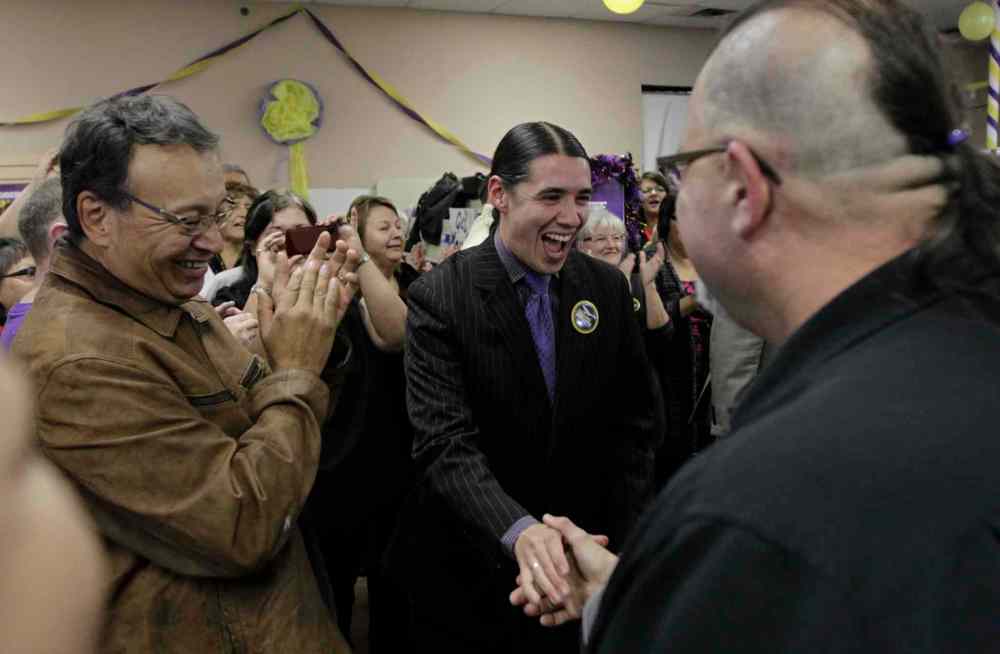Ouellette attracted unlikely voters to make inroads into downtown neighbourhoods
Advertisement
Read this article for free:
or
Already have an account? Log in here »
To continue reading, please subscribe:
Monthly Digital Subscription
$19 $0 for the first 4 weeks*
- Enjoy unlimited reading on winnipegfreepress.com
- Read the E-Edition, our digital replica newspaper
- Access News Break, our award-winning app
- Play interactive puzzles
*No charge for 4 weeks then billed as $19 every four weeks (new subscribers and qualified returning subscribers only). Cancel anytime.
Read unlimited articles for free today:
or
Already have an account? Log in here »
Hey there, time traveller!
This article was published 24/10/2014 (3472 days ago), so information in it may no longer be current.
2014 election results by polling subdivision
Brian Bowman won the majority of votes in blue areas, while Judy Wasylycia-Leis took the red areas and Robert-Falcon Ouellette took the yellow areas.
If you cannot see the map above, click here.
Robert-Falcon Ouellette, the surprise third-place finisher in this week’s mayor’s race, scored well in downtown neighbourhoods and captured votes in areas that usually register a low turnout.
Returns from polling stations show Ouellette, a 37-year-old Cree and University of Manitoba administrator, won 15.7 per cent of the vote behind winner Brian Bowman and runner-up Judy Wasylycia-Leis, the heavy favourite throughout much of the race. He had started the campaign as a virtually unknown outsider, and analysts said the outcome could prompt politicians to pay greater attention to aboriginal and other inner-city voters.
While Bowman won by a wide margin and took most of the city, especially the suburbs, Ouellette came first in several city centre districts — possibly eating into what might have been Wasylycia-Leis’s support.

“I’m amazed by it,” Ouellette said by phone, after seeing a Free Press map of election results by polling subdivision — small areas of 700 to 800 voters.
These results put Ouellette ahead in areas around the University of Winnipeg, West Broadway, Armstrong’s Point, The Forks and some areas around Osborne Village. He also came out top in a couple of subdivisions in St. Boniface and three in the North End. “It’s an affirmation, essentially, that if you do speak to something really important to groups of society, that they respond in a positive way,” he said, expressing surprise he had come first in so many areas.
Ouellette holds three degrees, including a doctorate, and oversees an Aboriginal Focus Program at the U of M. His research includes the interaction between city government and the 70,000-strong aboriginal community.
“There might have been a question of symbolic representation, he’s aboriginal, but he was also speaking directly to their issues,” said Royce Koop, a U of M political science professor who follows municipal politics.
“The truth is aboriginal people have not had too many opportunities to vote for mayoral candidates who are aboriginal. Ouellette was articulate and smart, and he was on the upswing. He came in ahead of Gord Steeves for goodness’ sakes. It’s crazy.”
Ouellette won support from neighbourhoods with a high concentration of indigenous people, and Koop says that strategy of reaching out to unlikely voters worked.
“This was a campaign that was focused on bringing out marginalized people, aboriginal, youth, people who aren’t typically big players in municipal elections,” Koop said.
“Maybe the candidates (in the next election) will feel like they should be promoting voting amongst these groups. It’s not a waste of time, it’s something that can actually pay off for a campaign.”
Ouellette won increasing attention during the campaign and surged into third place in a Global News/CJOB Insightrix poll issued two days before the election. There was a sense he was eating into the support for Wasylycia-Leis.
“He looks much closer to Judy on the political spectrum than Brian Bowman, so it looks likely he took votes from her,” said Christopher Leo, an urban politics researcher and retired University of Winnipeg professor.
“But he’s not to blame for her loss.” Bowman’s lead was far greater than Wasylycia-Leis’s and Ouellette’s vote combined.
Koop pointed out left-leaning voters opted for Ouellette, despite any suggestion that might hurt Wasylycia-Leis’s chances.
“I think it shows that people on the right in the city, to be honest, are probably more pragmatic than people on the left,” Koop said.
inayat.singh@freepress.mb.ca
History
Updated on Monday, October 27, 2014 11:42 AM CDT: Updated with 2014 map of subdivision boundaries


